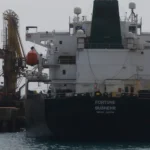
China’s technological escalation puts pressure on the US, which turns to Patriot missiles to face hypersonic threats and reinforce its naval defense in the Pacific
Fearing that China could deploy hypersonic weapons to sink ships in the Pacific, the U.S. Navy is moving forward with a plan to equip some of its ships with Patriot interceptor missiles, according to two senior defense officials.
An industry representative said placing the highly agile Patriot Advanced Capability-3 Missile Segment Enhancement (PAC-3 MSE) interceptors, used primarily by the U.S. Army, aboard Navy ships anticipates advances in Chinese missile technology, including hypersonic weapons. high maneuverability.
Integrating Lockheed Martin-made missiles into ships’ air defense systems comes amid rising tensions in the Indo-Pacific region as China rapidly modernizes its military, and following missile defense successes in Ukraine and the East Average.
It’s not yet clear how many PAC-3 interceptors the Navy will need, but overall demand is “through the roof,” said Tom Karako, a missile defense expert at the Center for Strategic and International Studies in Washington.
He said there is strong interest from foreign governments and that the US Army intends to more than double production in the coming years.
The US has chosen Japan, a key ally, as a site for joint production of Patriot missiles, while Lockheed Martin plans to establish a new seeker production line for the missiles in Florida, according to industry sources.
Such a plant would complement Boeing’s seeker manufacturing efforts, and Lockheed Martin is touting the benefits of additional production to the U.S. Army, which must approve the project.
The PAC-3 has already intercepted maneuverable hypersonic missiles in Ukraine. The Navy believes it could add a high-probability layer to its anti-missile systems, which have not yet been tested in combat against these weapons.
The Navy told Reuters that “further testing is needed on the development roadmap, including launching the PAC-3 MSE from a ship and validating communication with the SPY-1 radar,” the Aegis missile system’s main sensor.
This adds to efforts by the US military that have already produced new weapons and strategies in the Indo-Pacific, aimed at deterring Beijing from a conflict or winning it if it occurs.
China’s most sophisticated anti-ship ballistic missile, the DF-27, which uses a hypersonic glide vehicle to maneuver to its target, was tested in 2023. The Pentagon’s military report on China that year stated that the weapon was still “in development ”.
The PAC-3 has a shorter range than the Navy’s SM-6 missiles and cannot hit targets in space.
However, its near-nose homing rockets make it more agile, increasing the likelihood of target destruction due to the “direct hit” concept, where the interceptor collides with the target rather than exploding near it, a director explained. of missile defense program familiar with the Aegis system.
Given advanced Chinese weapons, including maneuverable hypersonic warheads, these qualities “complement existing missiles on US ships very well,” allowing them to more easily target fast, maneuverable ballistic missiles and destroy them, the program director said.
Like other industry and defense representatives, he preferred not to be identified as he was not authorized to speak to the media.
Growing threat
A PAC-3 interceptor of a Patriot missile system, used primarily by the U.S. Army and allied nations for land-based air defense, was tested in May on an “Aegis virtual ship” with a Mk vertical launcher. 70, but has not yet been deployed on naval vessels.
Over the past year, however, it has intercepted numerous ballistic threats and aircraft in the Middle East and Ukraine, including Russia’s advanced Khinzal missiles, making it an attractive addition to the Navy’s arsenal, according to defense officials and sources familiar with the matter. .
The PAC-3 is smaller than the SM-6 or SM-3 missiles, weighing about 300 kg compared to the SM-6’s 1,500 kg, and has a diameter about 9 cm smaller.
The cost per missile varies by customer and contract, but both cost about $4 million each, according to estimates.
China has already developed a formidable arsenal of anti-ship ballistic missiles, including the DF-21D, known as the “carrier killer,” and anti-ship warheads for its DF-26 intermediate-range ballistic missile.
The DF-27, which according to the Pentagon can reach up to 8,000 km, appears to use an aerodynamic warhead capable of maneuvering to evade defenses or hit moving targets more easily, explained Tim Wright of the missile defense team at the International Institute for Strategic Studies .
With information from Reuters*
Source: https://www.ocafezinho.com/2025/01/09/eua-reagem-ao-avanco-chines-com-armas-de-outra-era/

